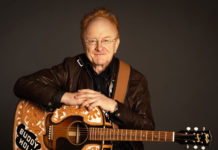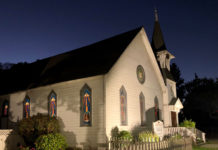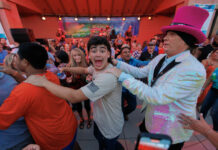The South Valley’s Japanese-American community will celebrate
its 50th annual Haru Matsuri on Sunday, April 18 at the Morgan Hill
Buddhist Community Center. If you and your family happen to go to
this year’s spring festival celebrating life and friendship, I hope
you might pause to consider the poignant history behind this
cultural event.
The South Valley’s Japanese-American community will celebrate its 50th annual Haru Matsuri on Sunday, April 18 at the Morgan Hill Buddhist Community Center. If you and your family happen to go to this year’s spring festival celebrating life and friendship, I hope you might pause to consider the poignant history behind this cultural event. Behind the festivities lies a story affirming how the human spirit can triumph over great injustice.
In 1887, about 400 Japanese lived in California. In the 1890s, state legislation restricting Chinese workers caused a shortage of cheap labor. So in the last decade of the 19th century, people from Japan immigrated to the Golden State for the opportunity to work hard and make enough money to purchase small share-cropper farms.
By 1910, more than 41,000 Japanese lived in California. More than half of these people owned farms or worked in the agricultural industry. Many of them lived in the fertile Santa Clara Valley where they planted orchards of pear, apricot and prune trees and “intercropped” peppers, spinach, strawberries and other crops along the rows of the young trees. In the Sacramento Valley, Japanese immigrants were the first to successfully grow rice on land once thought unsuitable for farming, thus creating what is now a $1.3 billion industry.
In the South Valley region, many Japanese immigrants worked in the sugar beet fields of the Coyote Valley. In Gilroy, an enterprising farmer named Kiyoshi “Jimmy” Hirasaki took a stab at growing the garlic herb. Thanks to Hirasaki, the South Valley community gained international fame as the “Garlic Capitol of the World.”
Unfortunately, with the rising success of these immigrants, an anti-Japanese movement grew in California. Laws were passed to limit Japanese land ownership. An anti-miscegenation law passed in 1909 prevented Japanese from marrying white citizens.
When Japan’s navy fleet attacked Pearl Harbor on Dec. 7, 1941, prejudice felt toward Japanese-American citizens rose to an even higher pitch. The federal government mandated that for “national security,” people of Japanese heritage living on the West Coast would be placed in internment camps.
Men, women and children were sent to regions such as Manzanar and Tule Lake in California and Heart Mountain in Wyoming. Families could bring only what they could carry in suitcases. Many were not told their destinations, so they failed to prepare properly.
As the war with Japan raged in the Pacific, California’s bigotry grew. In 1943, San Jose and Morgan Hill’s city councils and the Santa Clara County Board of Supervisors passed resolutions excluding Japanese-Americans from their communities.
With the close of World War II, Japanese-Americans started returning to the South Valley region. The first came back in January 1945 – mostly men from the Heart Mountain internment camp who journeyed here hoping to find work and make homes for their families. On June 7, 1945, their wives and children arrived by train to join them.
Many displaced families who had lost their property during internment faced overwhelming challenges as they started from scratch to recreate new lives. Some settled in what’s now San Jose’s Japantown.
Santa Clara Valley farmers during this post-war period recalled the work ethic demonstrated by the Japanese-Americans before the war. They employed them and built simple quarters as their homes. Among the farmers local Japanese-Americans still speak of with great respect are brothers Ned, George and Donald Driscoll who hired many former internees to pick strawberries on 150 acres of Morgan Hill fields.
Over the next decade, the Japanese-American workers rebuilt their lives. Bonded by the shared trauma of the internment experience, they also created a vibrant community in the South Valley region.
The Hanamoto family were among those who came to Morgan Hill to sharecrop on the Driscoll fields. They saved enough money to purchase a farm north of the town in 1952. They were also active in the Buddhist Center here and played a part with other families in creating the first Haru Matsuri festival in Morgan Hill. The first festival – called an “Oriental Food Sale” – was held Nov. 8, 1959, at the Friendly Inn in Morgan Hill. Proceeds went to buy a “Butsudan” altar for the Buddhist Community Center.
The festival has since grown into a fun annual spring tradition for South Valley residents of all heritages. For me, the Haru Matsuri symbolizes something powerful. After passing through a winter of injustice, California’s Japanese-Americans found themselves at the symbolic spring of new lives. They experienced a rebirth as a community – and gave a gift of a beloved Japanese festival to the South Valley region.







